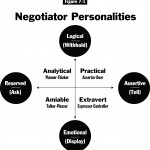Anticipating a Negotiator’s Style

"Shorten your sales cycle & increase your win rate through competitive excellence"
Editors note: Stu Schlackman is a regular guest contributor to this blog.
Robert Menard’s book “You’re the Buyer-You Negotiate It” does an excellent job assessing the characteristics of the four personalities as it relates to their negotiating style. Robert uses a model which expresses their styles in terms of Analytical, Amiable, Practical and Extravert which nicely correlates to our model of Green, Blue, Gold and Orange.
The Model
The model shows a chart with four axes that categorizes their style in regards to whether they lean towards Reserved (Ask) or Assertive (Tell) on the horizontal axis and Logical (Withhold) or Emotional (Display) on the vertical axis. We’ll call the vertical axis the Reason/Emotion line. This correlates to the top left brain quadrant that favors thoughts over feelings and the bottom right brain quadrant favoring feelings over thoughts. The horizontal axis is known as the Assertiveness line. Those that are reserved prefer asking and those that are assertive prefer telling.
In our model this all translates to:
- Analytical Greens
- Amiable Blues
- Practical Golds
- Extravert Oranges
 Applying the Model
Applying the Model
The Green style for negotiations is high reason and low assertiveness. They think carefully and methodically and ask the tough questions. They will read up in advance and have all the information prepared when getting ready for the negotiation. They hold their cards close to the vest and battle with logic.
The Blue style is high emotion and low assertiveness. They follow the rules and value the Win-Win result in order to build a long term relationship with the client. Blues are more likely to acquiesce to satisfy the needs of the client.
The Gold style is high assertiveness and high reason. Golds will go point for point and can get aggressive when negotiating. Deadlines and timeframes are critical to their needs. Golds also tend to fall into the profession of finance, law and many times purchasing and procurement.
The Orange personality is high assertiveness and high emotion. Oranges look at the negotiation as a game. They need to score points and feel like they have won. It’s important for the other side to win, but the Orange must have their needs met. Oranges also lack patience if a negotiation takes a long period of time.
Business and Personal Applications
Negotiating is a common practice in the business world both between buyers and sellers and also internally throughout the various organizations within a company. There are two aspects to a negotiation. There is a business component as well as a personal one. Both are equally important but if you can determine the other side’s personality style you will be able to discern which might actually be more important. Your right brained negotiators are Orange and Blue and tend to focus on the personal aspects of the negotiation, the subjective criteria and the intangibles. Your left brained negotiators will lean towards the business aspects and focus on the objective points and the tangibles.
To negotiate successfully, keep the following in mind:
- What are the critical points of contention that are keeping you from gaining agreement?
- Can you weigh the importance of those points from your perspective versus the other side?
- What can you give up that is important to the other side that is not hurting your financial position?
Sometimes intangible points are just as important as the tangibles. It all depends on how they are valued by the other side. Knowing their personality style can gain you that extra edge it takes to make the deal happen!